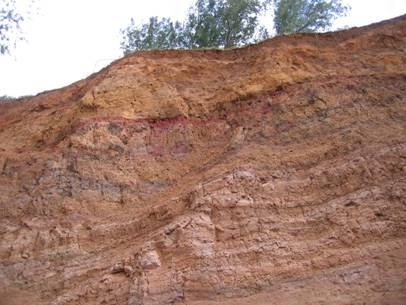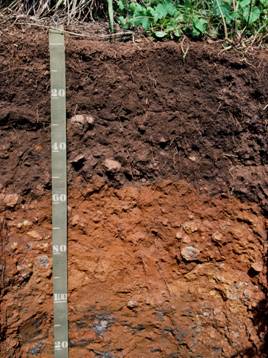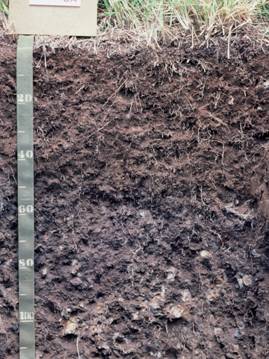soil is formed by weathering. weathering is a process in which rocks break down to smaller fine pieces by the action of winds. when these small fine pieces are mixed with humus and minerals, it formes soil.
- -1
In th every begining , the earths crust was made up of thick layers of rocks. These rocks were heated up by the sun and cooled down by the rain. Alternate heating and cooling cracked the rocks. Rains falling over heated rocks caused them to break due to sudden cantraction.When it rained over cracked rocks , water entered the cracks. In winters this water froze into ice. Ice in the crevices of rocks expanded and caused the rocks to break into smaller pieces. Due to strong winds and other natural causes , these rocks hit each other and broke into even smaller pieces. This is how the thin layer of soil on the eatrh's crust was formedover thousands of years.Soil formation is a slow proscess and occurs all the time. It takes thousands of years to form a layer of soil.
Hope this helps you............
- -1
The formation of soil happens over a very long period of time. It can take 1000 years or more. Soil is formed from the weathering of rocks and minerals. The surface rocks break down into smaller pieces through a process of weathering and is then mixed with moss and organic matter. Over time this creates a thin layer of soil. Plants help the development of the soil. How? The plants attract animals, and when the animals die, their bodies decay. Decaying matter makes the soil thick and rich. This continues until the soil is fully formed. The soil then supports many different plants.
Weathering:
Weathering is the process of the breaking down rocks. There are two different types of weathering. Physical weathering and chemical weathering.
In physical weathering it breaks down the rocks, but what it's made of stays the same. In chemical weathering it still breaks down the rocks, but it may change what it's made of. For instance, a hard material may change to a soft material after chemical weathering.
Stages in the Formation of Soil


stage 1 stage 2

stage 3 stage 4
- 5
The formation of soil happens over a very long period of time. It can take 1000 years or more. Soil is formed from the weathering of rocks and minerals. The surface rocks break down into smaller pieces through a process of weathering and is then mixed with moss and organic matter. Over time this creates a thin layer of soil. Plants help the development of the soil. How? The plants attract animals, and when the animals die, their bodies decay. Decaying matter makes the soil thick and rich. This continues until the soil is fully formed. The soil then supports many different plants.
Weathering:
Weathering is the process of the breaking down rocks. There are two different types of weathering. Physical weathering and chemical weathering.
In physical weathering it breaks down the rocks, but what it 's made of stays the same. In chemical weathering it still breaks down the rocks, but it may change what it 's made of. For instance, a hard material may change to a soft material after chemical weathering.
Stages in the Formation of Soil


stage 1 stage 2 

stage 3 stage 4
- -1
The soil profile is an important tool in nutrient management. By examining a soil profile, we can gain valuable insight into soil fertility. As the soil weathers and/or organic matter decomposes, the profile of the soil changes. For instance, a highly weathered, infertile soil usually contains a light-colored layer in the subsurface soil from which nutrients have leached away. On the other hand, a highly fertile soil often has a deep surface layer that contains high amounts of organic matter. With clues provided by soil profile, we can begin to predict how a soil will perform under certain nutrient management conditions.
In the previous section, we looked at how soil is actually an integration of water, air, minerals and organic matter. Now we will view the soil as a vital part of the earths physical landscape.
The worlds soils are like blankets that cover most of the earths land surfaces. We could not survive without it since most crops would not be able to grow in the dense rock that lies underneath. There is no uniform depth to our earths soils. While it can be absent in places of exposed bedrock, soil may extend up to tens of meters into the earths surface. Although this may not seem insignificant when compared to the depth to the core of the earth, the soil profile can be very intricate and diverse. In fact, the soil profile is made up of distinct layers, known as horizons. The five most common horizons are collectively known as the master horizons. Figure 5 below depicts a road cut in Maui which shows the multitude of layers that can exist in soil. Though the soil profiles in Figure 6 belong to two very different soils, both contain distinct surface and subsurface soil layers.
Scientists have developed methods to describe the various components and characteristics of the soil profile. By using common terminology, soil profile descriptions are valuable for deciding how the soil might be used and/or predicting how the soil might react to its intended use. Technical descriptions of the soil are not only useful for farmers, but for scientists, ecologists, soil engineers, hydrologists and land use planners.

Figure 5. View of a road cut in Maui. Road cuts are excellent ways to observe the layers, or horizons, within a soil profile. This particular soil profile is well developed and consists of many layers.


- 5
- 0
- 1
- 1
- 1
Weathering:
Weathering is the process of the breaking down rocks. There are two different types of weathering. Physical weathering and chemical weathering.
In physical weathering it breaks down the rocks, but what it's made of stays the same. In chemical weathering it still breaks down the rocks, but it may change what it's made of. For instance, a hard material may change to a soft material after chemical weathering.
- 1




